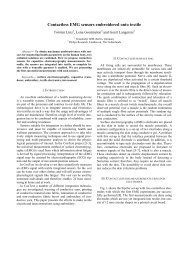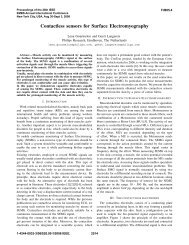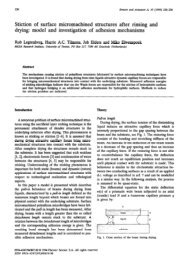Recording CD—R up to 56x - Geert's pages
Recording CD—R up to 56x - Geert's pages
Recording CD—R up to 56x - Geert's pages
Create successful ePaper yourself
Turn your PDF publications into a flip-book with our unique Google optimized e-Paper software.
<strong>Recording</strong> <strong>CD—R</strong> <strong>up</strong> <strong>to</strong> <strong>56x</strong><br />
Frank FL Tang**, George JY Zhong and David DY Chen<br />
Philips Research East Asia — Shanghai, China<br />
Benno Tieke and Geert R. Langereis<br />
Philips Research Labora<strong>to</strong>ries, Prof. Holstlaan 4, 5656AA Eindhoven, the Netherlands.<br />
ABSTRACT<br />
The most important performance parameter for CD-R recording is the recording speed. We have achieved recording speeds<br />
of <strong>up</strong> <strong>to</strong> 56X on CD-R with a data-<strong>to</strong>-data jitter of 25 ns that is well within Orange Book specification. This jitter is achieved<br />
at zero asymmetry and with a write power margin of 20% of the optimum recording power. In this paper, we present results<br />
on a number of CD-R media. Furthermore, we discuss the influence of write strategy parameters, such as laser power level,<br />
laser pulse length, pulse shape, etc., on the recording performance ofhigh speed CD-R.<br />
1. INTRODUCTION<br />
<strong>Recording</strong>/reading speeds are an important parameter and unique selling point of optical discs and drives. Since CD-<br />
Recordable was introduced <strong>to</strong> the market at the beginning of I 990's, efforts <strong>to</strong> increase its recording speed have never<br />
s<strong>to</strong>pped. The compatibility enforced by the standardization policy plays an important role <strong>to</strong> make CD-R have a strong<br />
position in the optical removable s<strong>to</strong>rage market. CD-R recording at <strong>up</strong> <strong>to</strong> 40x and 48x speed has been covered by the<br />
Multi-Speed CD-R standard. At such high recording speed, a drive can almost write as fast as it can read.<br />
In this paper, we report how <strong>to</strong> write CD-R discs <strong>up</strong> <strong>to</strong> <strong>56x</strong> and the fac<strong>to</strong>rs influencing the writing performance at the high<br />
speed.<br />
2. THERMALLY BALANCED WRITE STRATEGY FOR HIGH-SPEED CD-R<br />
One ofthe most important quality parameters of CD-R data recording is the jitter in the pit-length and land-length. The pitlength<br />
and land-length are determined by the positions of pit-edges. At low recording speed, the in-track thermal<br />
interference can be neglected. The neighbor laser pulses <strong>to</strong> burn previous and next pits hardly affect the edge position of the<br />
pit <strong>to</strong> be written. The main concern of a write strategy is how <strong>to</strong> make a steep temperature gradient in the recording layer so<br />
that the position ofthe pit-edge can be burnt accurately. Therefore the proposed write strategy for low speed CD-R [1] starts<br />
with an increased power level "t\P" during the first I .5 clock cycles. A pulse shortening of 0=0.5 <strong>to</strong> 0=1 .0 is used <strong>to</strong><br />
compensate for the spot size.<br />
However, the same write strategy cannot be applied at higher speed (>8x) because the in-track thermal interference will<br />
become very serious at high-speed recording. Huge heat from the neighbor pits will diffuse <strong>to</strong>wards the pit that is <strong>to</strong> be<br />
written. In such a situation, the position of the edge-pit is not only determined by the laser pulse imposed on the pit <strong>to</strong> be<br />
written but also affected by the so-called pre-heat and post-heat which are shown in figure 1 . The lengths of the previous<br />
land and next land mainly determine<br />
_<br />
the amount of the pre-heat and post-heat diffused <strong>to</strong> the pit <strong>to</strong> be written. Because the<br />
lengths of the previous land and next land are random,<br />
—<br />
the pits <strong>to</strong> be written will be expanded _with a random magnitude.<br />
This will cause unacceptably high jitter.<br />
Previous Previous Actual Next Next<br />
pit land pit land pit<br />
Pre-heat Post-heat<br />
Figure 1: In-track thermal interference: the effect of pre-heat and post-heat<br />
*<br />
Philips Research East Asia — Shanghai, 38th floor, Office Building Tower 1, Kerry Everbright City, 218 Tian Mu Xi Road. Shanghai<br />
200070, P. R. China Email: frank.tangphilips.com<br />
20<br />
Sixth International Symposium on Optical S<strong>to</strong>rage (ISOS 2002), Fuxi Gan, Zuoyi Li, Edi<strong>to</strong>rs,<br />
Proceedings of SPIE Vol. 5060 (2003) © 2003 SPIE · 0277-786X/03/$15.00
To compensate for the in-track thermal interference, a thermally balanced writes strategy has been developed <strong>to</strong> cover the<br />
speed range from 4x <strong>to</strong> 48x. It has been included in the Multi-Speed CD-R standard as media testing condition. It is shown<br />
in figure 2 [2, 3, 4]. In the thermally balanced write strategy, the leading edge of a write pulse is delayed (t) when the<br />
previous land is 3T. In addition, write equalization for 3T pits is applied by means of a tsP.<br />
s AP(3T-pit only)<br />
e ii<br />
F1<br />
t±::: 1 :1 1 4 11<br />
I I t I<br />
n-0 , I<br />
Figure 2: Thermally balanced write strategy<br />
Write level<br />
Read level<br />
3. WRITING CD-R AT 48X<br />
A lot of CD-R discs including phthalocyanine, cyanine and azo CD-R were experimentally written at 48x using the<br />
thermally balanced write strategy. Figure 3 and figure 4 depict the power margin for 48x writing of a phthalocyanine CD-R<br />
disc and EFM eyepattern respectively. All jitters are below 35ns (CD-spec). Asymmetry is between —5%and 6%. In<br />
addition, modulation is bigger than 66%. The power margin is 9mW (16%). Generally, the power margin for 48x writing is<br />
bigger than 1 5% ifthe thermally balanced write strategy is used. Large power margins are achieved also for cyanine and azo<br />
CD-R discs at 48x writing. Of course, the writing performance strongly depends on the CD-R quality as well as the write<br />
strategy.<br />
40 -—<br />
35 -<br />
.;. 30<br />
C •:<br />
I:: 15<br />
45 50 55 60 65<br />
Write power (mW)<br />
: ::.<br />
0<br />
••:: •.::<br />
Figure 3: Power margin for 48x Figure 4: EFM eye pattern of 48x<br />
writing (phthalocyanine CD-R) writing (phthalocyanine CD-R)<br />
In order <strong>to</strong> achieve a large power margin for 48x CD-R writing, write parameters of the thermally balanced write strategy<br />
must be optimized because recording performance strongly depends on them. -r mainly influences pit jitter. tsP mainly<br />
affects land jitter. Figure 5 depicts an example. In this case, 2T/l6 and 4% are the optimum parameters for -r and tsP<br />
respectively.<br />
CD-spec.<br />
•tatuFa_ewatS Pit<br />
Gsas&a.aalBsEJ Land<br />
Proc. of SPIE Vol. 5060 21
Cl)<br />
70<br />
60<br />
50<br />
30<br />
' 20<br />
10<br />
Pit<br />
70<br />
60<br />
50<br />
40<br />
:-) 20<br />
0<br />
0<br />
0 1 2 3 4 0 5 10 15<br />
IIay (T116)<br />
10<br />
Delta P (%)<br />
Figure 5 : The influence of t (delay) and \P on the jitter of a CD-R disc<br />
Another fac<strong>to</strong>r influencing the writing performance of 48x CD-R recording is the laser pulse length (9). Pulse length has a<br />
big influence on the write power and jitter. Figure 6 depicts an example. Long pulses have the advantage of low power, but<br />
<strong>to</strong>o long pulses can affect the jitter. Therefore, depending on a disc characteristic, a compromise between power and jitter<br />
has <strong>to</strong> be found.<br />
60<br />
50<br />
U)<br />
' 30<br />
20<br />
10<br />
CD-spec.<br />
40 a . A I Pit<br />
0<br />
40 45 50 55 60<br />
Writing power (mW)<br />
Figure 6: The influence of laser pulse length on the power margin of an azo CD-R<br />
Overall, the thermally balanced write strategy can be used <strong>to</strong> write CD-R at 48x. All parameters after recording are well<br />
within CD and CD-R specification. A large power margin can be achieved if optimum writes parameters are used. The<br />
Multi-Speed CD-R standard has been <strong>up</strong>graded <strong>to</strong> 48x successfully. The thermally balanced write strategy was adopted as<br />
the manda<strong>to</strong>ry write strategy for media testing in the standard. 48x will be the final speed specified in CD-R standardization<br />
because it approaches <strong>to</strong> the mechanical limit of drive mo<strong>to</strong>r and CD-R substrate. This result suggests that the speed race for<br />
Recordable DVD's will also continue <strong>to</strong> such a final speed of67mls (16 <strong>to</strong> 20x DVD).<br />
4. ACHIEVING RECORDING SPEED HIGHER THAN 48X<br />
0 0 L 0 Land<br />
Although 48x will be the final speed for CD-R standard, it is very interesting <strong>to</strong> see what will occur at recording speed<br />
higher than 48x. In Philips Research-Shanghai labora<strong>to</strong>ry, we successfully demonstrated the <strong>56x</strong> CD-R recording with<br />
thermally balanced write strategy. The power margin and jitter-asymmetry curves of <strong>56x</strong> recording of an azo CD-R are<br />
depicted in figure 7. Figure 8 shows the power margin of an azo CD-R disc from 4x <strong>to</strong> <strong>56x</strong> written by thermally balanced<br />
write strategy. In every speed, the power margin is bigger than 20%.<br />
22 Proc. of SPIE Vol. 5060<br />
65
This result shows that the recording speed of the dye layer is not limited by the write strategy but only by other fac<strong>to</strong>rs such<br />
as the max mo<strong>to</strong>r speed or available laser power.<br />
50<br />
Cl)<br />
£ 40<br />
(I)<br />
C<br />
I-<br />
50<br />
40<br />
.30<br />
-)<br />
'20 anc<br />
I-<br />
CV)<br />
20<br />
55 60 65 70<br />
SMite pover(mW)<br />
10<br />
5 15 25 35 45 55 65 75<br />
50<br />
Cl)<br />
£40<br />
20<br />
10<br />
-0.20<br />
Figure 7: Power margin for <strong>56x</strong> CD-R recording and jitter-asymmetry curves<br />
Writingpower (mW)<br />
Figure 8: Power margins of a CD from 4x <strong>to</strong> <strong>56x</strong><br />
5. CONCLUSIONS<br />
<strong>Recording</strong> CD-R at <strong>56x</strong> was successfully achieved by using the thermally balanced write strategy invented by Philips<br />
Research. All parameters after recoding are within the CD-R standard. A large power margin of bigger than 15% is<br />
achievable if optimum writes parameters are used. 67m/s maybe the final speed of organic dye as write-once optical<br />
recording media because other fac<strong>to</strong>rs will limit a further increase ofrecording speed.<br />
REFERENCES<br />
-0.10 000 0,10 0.20<br />
ey<br />
I . Recordable Compact Disc Systems, Part II: CD-R, Volume 1 : lx/2x14x, Version 3 .1 , System description, December<br />
1988.<br />
2. Recordable Compact Disc Systems, Part II: CD-R, Volume I : Multi-speed CD-R, tentative, Version 0.9, December<br />
2000.<br />
3. B. Tieke, G. R. Langereis, E. R. Meinders, J. G. F. Kablau, R. Woudenberg, and R. A. J. van Kollenburg, "Thermally<br />
balanced writing for high speed CD-R recording", Technical Digest ISOS'Ol, page l90-191,Taipei, Oc<strong>to</strong>ber 2001.<br />
4. Recordable Compact Disc Systems, Part II: CD-R, Volume 1: Multi-speed CD-R, Version 1.2, April 2002.<br />
Proc. of SPIE Vol. 5060 23







